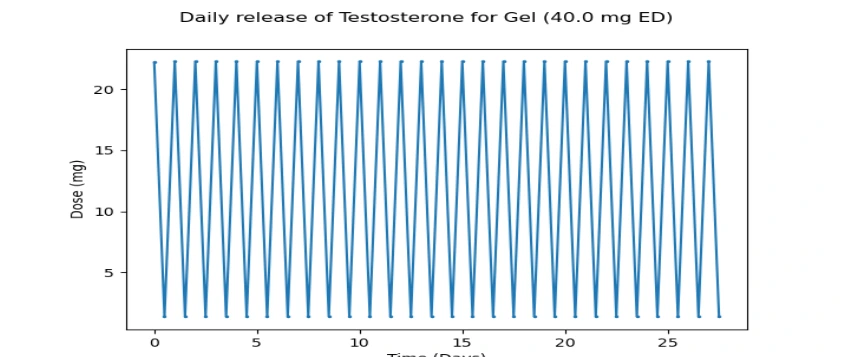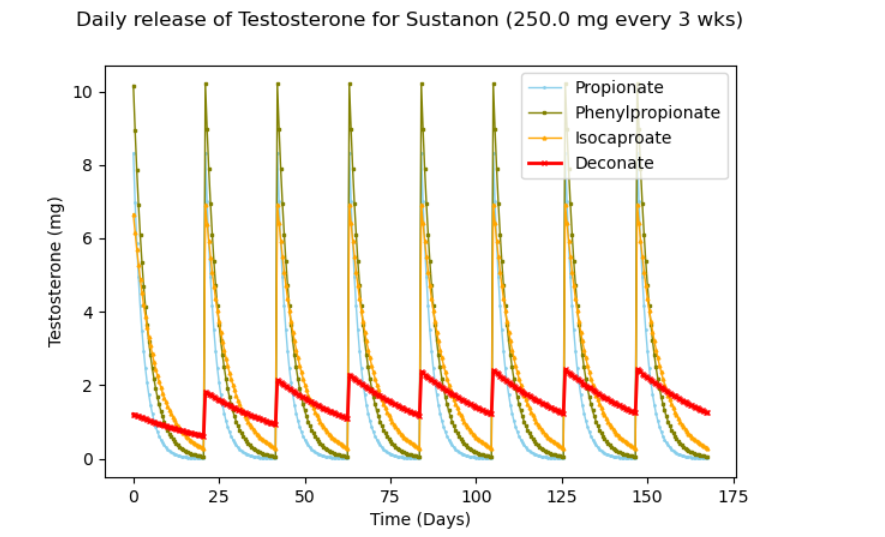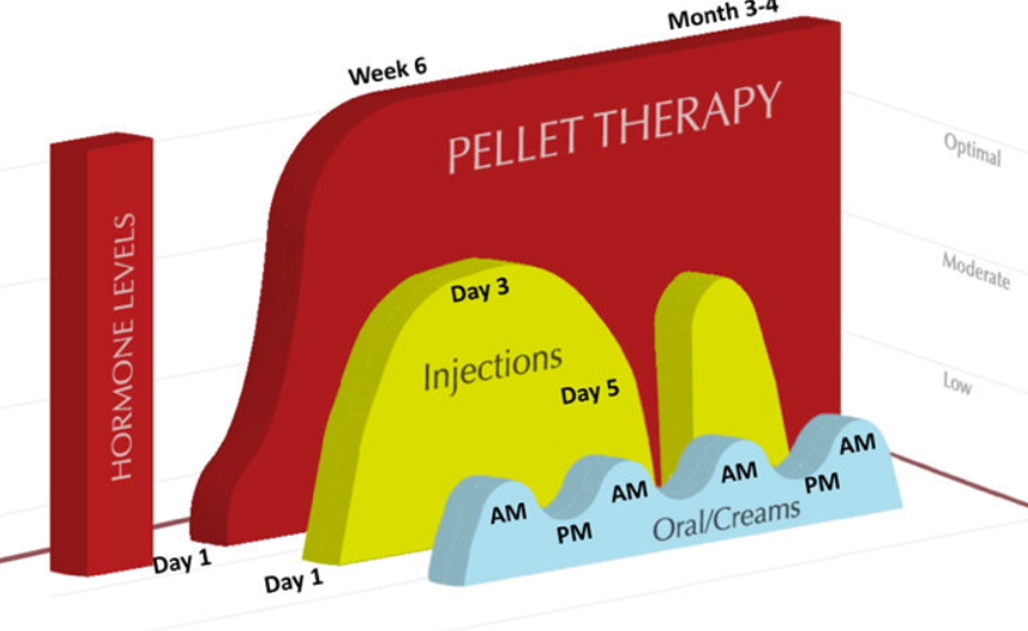
Steady Testosterone Release, Natural Results
As we age, our bodies change, and so do our sexual experiences. It’s a topic many shy away from, but it’s crucial because sexual health is a key part of overall well-being. Ignoring this can lead to larger issues, affecting both sexual vitality and overall health. My father’s experience, as I’ll explain, is a strong reminder of how interconnected these aspects of health are.
Table of Contents
- The Pharmaceutical-FDA Connection
- The Supermarket Analogy: Natural vs. Processed Hormones
- The Roller Coaster Effect of Weekly Injections
- Gels: Daily, But Still Fluctuating
- Testopel: A Smoother Option, but Still Synthetic
- Bioidentical Menopausal Hormone Therapy Pellets: The Closest to Natural
- Is It Worth the Expense?
- Steady Release, Natural Results
- The Final Choice: Is It Worth It?
Understanding Testosterone
Testosterone is a vital hormone produced by the gonads (sex organs) in people assigned male at birth (AMAB) and the ovaries in people assigned female at birth (AFAB). Additionally, the adrenal glands produce dehydroepiandrosterone (DHEA), which is converted into testosterone and estrogen in the body. This hormone plays a crucial role in maintaining muscle mass and strength, bone density, libido and sex drive, and red blood cell production in men. Essentially, testosterone is a cornerstone of overall health and well-being for men, influencing both physical and emotional states.
The Importance of Balanced Testosterone Levels
Balanced testosterone levels are essential for maintaining optimal health and well-being. When testosterone levels dip too low, men can experience a range of symptoms, including fatigue, low sex drive, erectile dysfunction, osteoporosis, and mood changes. Conversely, excessively high testosterone levels can lead to aggressive behavior, acne, and an increased risk of prostate cancer. Maintaining normal testosterone levels through a healthy lifestyle—such as a balanced diet, regular exercise, and adequate sleep—is crucial. This balance helps ensure that the body functions smoothly and reduces the risk of health complications.Our Pellets Provide Steadier, Bioidentical Hormone Therapy Levels
When considering testosterone replacement therapy (TRT), many men face a dilemma: Should they opt for cheaper, synthetic options covered by insurance, or invest in bioidentical testosterone pellets, which offer a more natural, steady release? Some synthetic options include testosterone propionate, which is often used in various hormone preparations. The distinction between these options involves not only how testosterone is produced but also the impact on your health and well-being.The Pharmaceutical-FDA Connection: Why Synthetic Testosterone Replacement Therapy is Covered
Synthetic testosterone products like Testim (a gel) and Testopel (a pellet) are widely available and covered by insurance because pharmaceutical companies have chemically altered the testosterone molecule, allowing them to patent and sell these products. Accurate measurement of testosterone concentrations is crucial for managing these therapies effectively. Natural bioidentical testosterone cannot be patented, making it less profitable for large companies and harder to get covered by insurance.
“Why create synthetic testosterone when natural testosterone works just fine?”“It’s all about money. Pharmaceutical companies can’t patent natural testosterone, so they create synthetic versions or tweak the delivery method to secure a patent. Once the FDA approves it, insurance only covers the patented, FDA-approved synthetic product. Big Pharma profits, the FDA justifies its role, and patients end up paying more while natural products are pushed aside.”The Supermarket Analogy: Natural vs. Processed Hormones
Think of it like the difference between buying organic produce and packaged processed foods. The processed, mass-produced foods—like synthetic testosterone—are cheaper and more accessible. Similarly, bioidentical menopausal hormone therapy is marketed as a more natural and safer alternative, but it comes at a cost. But the organic, natural foods—like bioidentical testosterone—are more expensive and harder to come by. They’re better for you, but they come at a cost.
“So bioidentical testosterone is like buying organic food?”“Exactly. It’s more natural, but it’s harder to find and costs more.”The Roller Coaster Effect of Weekly Injections
Weekly injections of synthetic testosterone often create a roller-coaster effect. Testosterone therapy, while beneficial for some, must be carefully monitored to avoid such fluctuations and potential health risks. Testosterone levels spike immediately after the injection, leaving men feeling energetic, but by the end of the week, levels drop sharply, causing mood swings and fatigue.
“I feel great after my injection, but by the weekend, I’m exhausted. Is that normal?”“Yes, that’s the downside of weekly injections. You get a big boost initially, but then levels drop quickly, leading to emotional and physical crashes.”
Gels: Daily, But Still Fluctuating
Daily testosterone gels, such as Testim, provide more frequent dosing but still lead to significant fluctuations in hormone levels. Testosterone treatment for conditions like male hypogonadism requires consistent hormone levels to be effective.

“I apply the gel daily, so why do I still feel up and down?”“Even with daily application, testosterone levels can still fluctuate. It’s more frequent than injections, but it doesn’t give you the steady release you need for consistent results.”
Testopel: A Smoother Option, but Still Synthetic
Testopel pellets provide a longer-lasting, smoother release of testosterone compared to injections or gels. In contrast, compounded bioidentical hormones are customized based on a clinician’s prescription, offering a tailored approach to hormone therapy. However, because Testopel uses synthetic testosterone, it does not match your body’s natural hormone structure, which can affect absorption and tolerability.
“Is Testopel better than injections or gels?”“It’s smoother than injections, but it’s still synthetic testosterone and not bioidentical.”Bioidentical Menopausal Hormone Therapy Pellets: The Closest to Natural
For men seeking the most natural and consistent option, bioidentical testosterone pellets are the clear choice. However, it’s important to monitor for potential side effects, such as weight gain, which can occur with hormone therapy. These pellets, chemically identical to the testosterone your body naturally produces, provide a steady release over time.
“What’s the big advantage of bioidentical pellets?”“They offer two major benefits: they are identical to your body’s natural testosterone, ensuring better absorption and fewer side effects, and they release steadily over time, avoiding the highs and lows of other treatments.”
Compounded Bioidentical Hormone Therapy
Compounded bioidentical hormone therapy (CBHT) is a specialized form of hormone replacement therapy that uses bioidentical hormones, which are chemically identical to those naturally produced by the body. CBHT is often employed to treat menopausal symptoms, low testosterone, and other hormone-related disorders. However, it’s important to note that the safety and efficacy of CBHT are not well established, and it is not regulated by the FDA. Therefore, patients should exercise caution and consult with a qualified healthcare professional to thoroughly discuss the potential risks and benefits before starting CBHT.
Accuracy of Hormone Level Testing
Accurate hormone level testing is a critical component in diagnosing and managing hormone-related disorders. The reliability of these tests can vary significantly depending on the method used and the laboratory performing the test. While salivary testing is often marketed for its convenience, it is not a reliable method for measuring hormone levels. Blood tests, on the other hand, are generally more accurate and provide a clearer picture of hormone concentrations. Patients should work closely with a qualified healthcare professional to determine the most appropriate testing method for their specific needs, ensuring they receive accurate and actionable results.
Patient Counseling
Patient counseling is a vital aspect of hormone therapy, ensuring that patients are well-informed about their treatment options and the associated risks and benefits. Patients should be educated on the potential risks of hormone therapy, including the risks of breast cancer, existing prostate cancer, and an increased risk of blood clots. Regular monitoring and follow-up appointments are crucial to ensure the safe and effective use of hormone therapy. Healthcare professionals should provide clear and concise information, addressing any questions or concerns patients may have, to help them make informed decisions about their treatment.
Is It Worth the Expense?
Bioidentical testosterone pellets cost around $2,400 per year, with four procedures required annually. Each involves the insertion of a small, rice-grain-sized pellet into the buttocks.
“Is it really worth spending $2,400 per year for bioidentical pellets?” “If you want smoother, consistent testosterone levels and a natural hormone match, it’s worth the investment. It comes down to your priorities for health and well-being.”Steady Release, Natural Results
The steady release of bioidentical testosterone pellets ensures men can maintain consistent hormone levels without the emotional highs and lows caused by injections or gels.
“So, with bioidentical pellets, I avoid the roller coaster effect?”
“Exactly. The slow, steady release mimics your body’s natural production, leading to consistent results without the crashes.”
The Final Choice: Is It Worth It?
Ultimately, the decision between synthetic and bioidentical testosterone depends on individual priorities. Synthetic options may be more practical for those focused on cost and insurance coverage. However, for men seeking a natural match to their body’s hormone production and steady, reliable results, bioidentical testosterone pellets are an excellent long-term investment.
Peak Masculinity
Starts Here

By Dr. Ryan Welter
August 18, 2025




